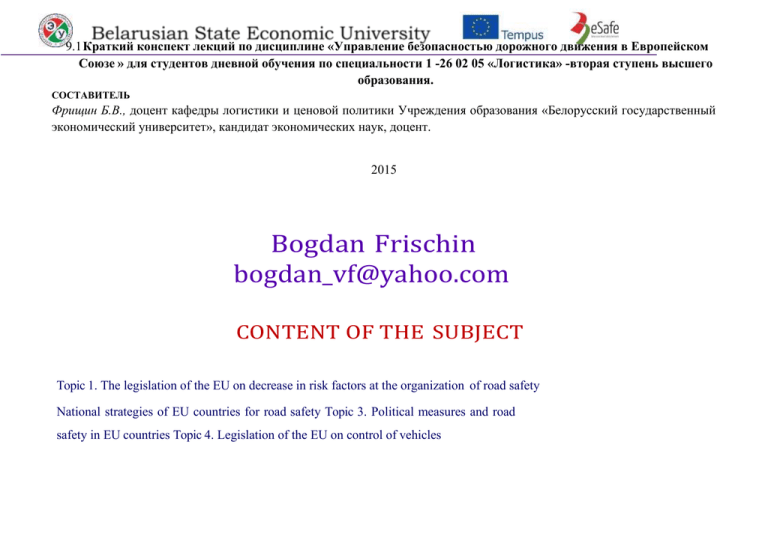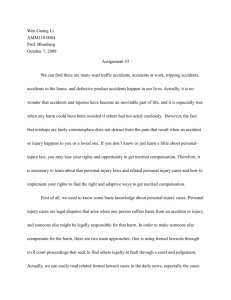Measures - Белорусский государственный экономический
advertisement

9.1 Краткий конспект лекций по дисциплине «Управление безопасностью дорожного движения в Европейском Союзе » для студентов дневной обучения по специальности 1 -26 02 05 «Логистика» -вторая ступень высшего образования. СОСТАВИТЕЛЬ Фрищин Б.В., доцент кафедры логистики и ценовой политики Учреждения образования «Белорусский государственный экономический университет», кандидат экономических наук, доцент. 2015 Bogdan Frischin bogdan_vf@yahoo.com CONTENT OF THE SUBJECT Topic 1. The legislation of the EU on decrease in risk factors at the organization of road safety National strategies of EU countries for road safety Topic 3. Political measures and road safety in EU countries Topic 4. Legislation of the EU on control of vehicles Topic 2. Road safety in EU countries The information systems used at the organization of road safety in EU countries Topic 3. Categories of participants of the road and transport accidents Road and transport traumatism and road safety in EU countries Topic4. An assessment of closses countries fromroad and transport traumatism in EU LITERATURE 1. Racioppi F et al. Preventing road traffic injury: a public health perspective for Europe. Copenhagen, WHO Regional Office for Europe, 2004. 2. Peden M et al., eds. World report on road traffic injury prevention. Geneva, World Health Organization, 2004. 3. Global status report on road safety. Geneva, World Health Organization, 2009. 4. Faces behind the figures. Voices of road traffic crash victims and their families. Geneva, World Health Organization, 2007. 5. European Health for All database [online database]. Copenhagen, WHO Regional Office for Europe, 2004. 6. Sethi D, Racioppi F, Mitis F. Youth and road safety in Europe. Copenhagen, WHO Regional Office for Europe, 2007 7. Lafl amme L et al. Addressing the socioeconomic safety divide: a policy briefing. Copenhagen, WHO Regional Office for Europe, 2009. 8. Edwards P et al. Deaths from injury in children and employment status in family: analysis of trends in class specific death rates. British Medical Journal, 2006, 333:119. 9. Sethi D et al. Reducing inequalities from injuries in Europe. Lancet, 2006, 368:2243–2250. 10. EMEP/CORINAIR emission inventory guidebook – 2006. Copenhagen, European Environment Agency, 2006 (EEA Technical Report, No. 11/2006). 11. Sethi D et al. Progress in preventing injuries in the WHO European Region. Copenhagen, WHO Regional Office for Europe, 2008. 12. Annual statistical report 2008. Brussels, European Road Safety Observatory, 2008. 13. European Road Safety Action Programme – mid-term review. Brussels, European Commission, 2006 (COM(2006)74 final). 14. The national road safety plan. Major elements of the plan. Tel Aviv, Committee for the Preparation of a National, Multi-year Road Safety Plan, 2005. 15. Transport policy guidelines and transport network investment and financing programme until 2020. Government transport policy report to Parliament, 2008. Helsinki, Ministry of Transport and Communication, Finland, 2008. Topic 1. National strategies of EU countries for road safety National road safety programs European countries that have road safetyprograms can be selected into three groups: • with the highest traffic safety (England , Sweden, Netherlands ) , • with an average level of traffic safety (Norway , Germany, Finland) • with the relatively low level of traffic safety (France and Italy). United Kingdom (Great Britain) Strategic framework for road safety Britain remains a world leader on road safety and that the relatively high risk of accidents amongst some groups, such as cyclists and children from deprived areas, is quickly reduced. United Kingdom (Great Britain) Strategic framework for road safety Key themes for UK road safety: • Making it easier for road users to do right thing and going with the grain of human behavior; • Better education and training for children and learner and inexperienced drivers; • Remedial education for those who make mistakes and for low-level offences, where this is more effective than financial penalties and penalty points; • Tougher enforcement for the small minority of motorists who deliberately choose to drive dangerously; United Kingdom (Great Britain) Strategic framework for road safety Key themes for UK road safety: • Extending this approach to cover all dangerous and careless offences, not just focusing upon speeding; • Taking action based upon cost-benefit analysis, including assessing the impact on business; • More local and community decision-making from decentralization, and providing local information to • citizens to enable them to challenge priorities; • Supporting and building capability by working with the road safety community on better tools to support road safety professionals. Norway Road Safety Strategy 2014-2024 National Plan of Action for Road Traffic safetyis published every fourth year, and is Norway Road Safety Strategy 2014-2024 The Plan of Action is based on four levels: • • Vision Zero - a vision of a transport system in which no one is killed or severely injured; Interim targets Reduction by 50% of the number of fatalities by 2024. No more than 500 fatalities and serious injuries by 2024.Indicator targets - targets for road user behavior, the stock of vehicles and the road network; • Measures – measures that help to reach one or several of the indicator targets traffic volume speed level safety standard of the vehicles use of electronic devices during driving Italy National Road Safety Plan Horizon 2020 • National Road Safety Plan, Horizon 2020, is being developed, in accordance with the actions and targets (50% fatalities) recommended by the European Commission • The main vision of the Plan is “No child should die on the road”. Italy National Road Safety Plan Horizon 2020 • • • The previous Road Safety National Plan (2001-2010) set a target to reduce the number of road fatalities by 50% between 2001 and 2010 (in line with the EU target) and to reduce the number of injuries by 20%. At the end of 2010, the fatality target was not reached, but nevertheless significant progress had been made during the last decade. In general, all the categories of road safety measures financed by the Plan 2001-2010 can be considered effective or fairly effective. For example, for the three most popular safety measures, i.e. "Roundabouts", "Redesign of intersections" and "Restoration and rehabilitation of roads", the observed injury road crashes reduction is more than 50%. the Plan allowed the realization of more than 1 600 local projects, co-funded by the Ministry of Transport. Italy National Road Safety Plan Horizon 2020 Targets: • -50% fatalities by 2020 (under consideration) (based on EU Road Safety target) • mid-term target (under consideration) an average annual reduction rate of fatalities of 7%, corresponding to a reduction of 38% in 2017 • (with reference to 2010 fatalities). Recommendations for Belarus • • Preparation Data collection analyses Goal and strategy • Projects • Effects and prioritization • Plan of action • Implementation Evaluation • and Recommendations for Belarus • Strategic target Example: "50% fewer fatalities by 2020" (EU target) • Operational (outcome) target Example: In 2020, traffic accidents should cause no more than 500 fatalities and 12,250 injuries." (Netherland) • Output target Example: "Number of police • officers trained to recognize drivers affected by narcotic or other psychotropic substances: 250 by 2014; 1000 by 2017" (Lithuania) Topic 2. Political measures and road safety in EU countries The European Commission (EC) in late 2010 adopted the so-called The main goal: • to halve the number of fatalities in twice in Europe in the next decade The measures : • improving vehicle safety • security infrastructure • ensuring safety behavior of participants of road traffic 1. Measures to ensure the safety of vehicles electronic stability of the vehicle warning system of departure vehicles with traffic lane Brake Assist safety belt reminder compulsory speed limiters for light commercial vehicles (vans) the optional introduction of advanced driver assistance systems, such as warning of a possible collision improvement of EU legislation in the sphere of technical inspections and control procedures of vehicles, and also about the mutual recognition of the results of such inspections 2.Construction of safety road infrastructure financing only those infrastructure projects that meet modern requirements of road safety and the requirements of directives for the providing safety in tunnels Consideration of the possible extension of the existing EU legislation on the safety of road infrastructure in the rural roads of EU Member States. The EU legislation established that the security requirements must be observed during the planning process, at the design stage and during the development of road infrastructure 3. Introduction of "smart technologies" It will be offered new technical requirements in the ITS Directive (Directive Intellectual Transport Systems) to provide free exchange of data and information between vehicles and between vehicles and the road infrastructure The EU Commission will accelerate the deployment of eCall (automatic alert system, which is triggered in an accident and through the channels of GSM- communication, transmits information about the car and its coordinates to the nearest or most convenient point of call) 4. The development of education and training of road users It is supposed to finalize the EU Directive on driving permits in the following directions: the formation of the minimum criteria for driversinstructors consideration of the possibility of introducing a probationary period after passing the driving test consideration the possibility of introducing the receptions of economical driving into theoretical and practical tests in order to ensure a safer and more ecological driving 5. Increase the effectiveness of interventions national plans for road safety by the EU Member States information campaigns in all countries of the European Union penalties for drunk driving should be accompanied by preventative measures. For example, EC will consider the legislative measures on compulsory use of alco-locks in relation to the drivers wich were arrested for drunk driving legislative measures aimed at international exchange of information in the area road safety. These measures allow to identify and apply sanctions to foreign violators 6. Reducing road traffic injuries European Union will implement the following: establish common criteria for the identification of serious injury and lung injury; - will facilitate the exchange between Member States of the EU by best practices for emergency medical assistance in traffic - accidents, and the collection of data on injuries and their analysis in all EU countries consider the possibility of developing and installing devices on vehicles , wich are intended for the registration of events ("black boxes") to conduct research and analysis of the causes of accidents. - Topic 3. Legislation of the EU on control of vehicles The United Kingdom The Legislative Framework for the work of Road Safety & Vehicle Regulation Division is largely contained under: • The Transport Act (NI) 1967 • The Road Traffic (NI) Order 1981 • The Road Traffic (NI) Order 1995 • The Road Traffic Offenders (NI) Order 1996 • The Taxis Act (NI) 2008 • The Goods Vehicles (Licensing of Operators) Act (NI) 2010 Legislation on speed Speed limits for Cars and vehicles in different countries Country Built-up areas km/h Single carriageway s km/h Dual carriageway s km/h Motorway s km/h The United Kingdom 48 96 112 112 Norway 50 80 80 80-110 Italy 50 70 90 110-150 Belarus 60 90 90 120 Drink-driving Blood Alcohol Content Drink Driving Limits By Country Country BAC (%) The United Kingdom 0,08 Norway 0,02 Italy 0,05 Belarus 0,04 Seat Belts and Child Restraints Legislation Country Legislation The United Kingdom Compulsory for occupants of all seats equipped with a seat belt. Children up to 3 years old in the front or rear seat MUST use the correct child restraint. It is illegal to carry a child in a rearfacing child seat in a front seat with an active frontal airbag. Children aged 3 and above, until they reach EITHER their 12th birthday OR 135 cm in height MUST use the correct child restraint in the front seat. In the rear seat they MUST use the correct restraint where seat belts are fitted. Children over 135 cm in height, or who are 12 or 13 years old, must wear an adult belt if available in the front or back seat. Recommendations for Belarus • • • More works need to be done to improve road safety legislation globally, such as: review current national legislation and regulations and identify barriers to the implementation and enforcement of effective road safety measures; identify available resources, such as international agreements, and evidence-based guidance and recommendations on effective measures, to improve legislation; prepare action plans to strengthen national legislation and regulations for the five main risk factors and for post-crash care, including advocating for improvement. Topic 4. Road safety in the EU countries Sweden - Vision Zero Base: the ethical principle of the inadmissibility of death and their received serious injuries on the roads Principles: Ethics, The chain of responsibility, Safety philosophy, Awareness of responsibility Ways to reduce accidents: - means of the seatbelt reminder (about 50% of people die not fastened) - ring decoupling instead of traffic lights - safety lanes - warning about leaving lane - replacement of two-lane roads in the three-lane (2 + 1), with the installation of barrier fence for the protection drivers from the opposing streams (in - Sweden, there are 2,100 kilometers of such roads) - alcolocks Speed limits when hitting by a car, when hitting by a car, the most people stay alive majority of people are killed safe car protects passengers at speeds up to 65-70 km/h in a frontal collision and at speeds up to 45-50 km h in side impact, on condition the use of seat belts by all passengers Results of the program: reducing the number of deaths in 25-33% over 10 years Finland - Program TARVA Objective: estimation of influence of measures for improving road conditions on road traffic safety allows to use resources as efficiently as possible Activity Measures Service of ECall roads in system winter Results -the general speed limits – 20 km/h - -Reduction of winter tires are accidents mandatory with victims -system placed inside the car device for emergency calls -The decrease in injury crashes by 28% - Reduction of fatal crashes by 49% - Positive environmental impact The decrease in the number of victims inside the car by 5-10% and the number of all victims in Finland by 4-8% Belgium - Multimedia theatrical monologue Project in the field of education, of promotion of traffic rules Base: multimedia monologue with live performances for young people and adults Objective: Preventing accidents with involving teenagers and young adults Principles: - clear language - animation - dynamic feed of information - lack of moralizing - discussion after viewing Netherlands. Advancing Sustainable Safety Base: people make mistakes and are physically vulnerable Objective preventing accidents minimizing consequences - predictability - vigilance Principles: - functionality roads accidents with T injuries - by 61%, of fatal accidents - by h 70% 2 Increaseethe number of people moving on foot and by bicycle R reduction 3 Significant traffic flows e in residential areas s the environmental • Improving situationroad signs u • road narrows l • humps t Architecture • landscape s : 1 Reducing the total number of traffic accidents by 27%, of The program for reducing traffic accidents on the roads Strategy and long-term program to improve road safety Road Safety infrastructure Technically equipped vehicles Education and propaganda campaign Driver training Transport enforcement activities Activities for the rehabilitation of perpetrators of road accidents (repeated examinations at the rules of the road) Medical assistance after an accident Statistics and data collection on road accidents . The information systems used at the organization of road safety in EU countries The United Kingdom • • Definitions Road fatality: human casualty who sustained injuries which caused death less than 30 days after the accident. Confirmed suicides are excluded. Serious injury: An injury for which a person is detained in hospital as an “in-patient”, or any of the following injuries whether or not they are detained in hospital: fractures, concussion, internal injuries, crushings, burns (excluding friction burns), severe cuts, severe general shock requiring medical treatment and injuries causing death 30 or more days after the accident. • • Slight injury: An injury of a minor character such as a sprain (including neck whiplash injury), bruise or cut which are not judged to be severe, or slight shock requiring roadside attention. This definition includes injuries not requiring medical treatment. Injury accident: accident in which at least one person is injured or killed The United Kingdom • There are two main sources of safety information in the United Kingdom: • The national road accident reporting system, STATS19, which includes information from police reports. • Hospital episode statistics (HES). Norway Definitions • Road fatality: person killed in a traffic crash or deceased because of an injury within 30 days after the crash. • The police do not use MAIS3+ to classify injuries, but this will be done in the future when injury data is provided by hospitals. In • the meantime, Norway will use a transformation factor to supply MAIS3+ data. Norway • Crash data are collected by the police and consolidated at national level by Statistics Norway and the Public Roads Administration. There are plans to use hospital data in the future. • Less severe crashes and injuries are often not reported to the police, and may therefore be under- represented in the figures (light injuries, single bicycle crashes). Italy Definitions: • Road fatality : any person killed immediately or dying within 30 days as a result of a road crash • Serious / slight injuries: In are not differentiated by degree of severity. In the crash statistics, injured persons reported field the current process will be adapted to EU decisions. In particular, Italy will adopt the MAIS3+ standard for coding the level of injury (procedures are still • to be defined). Italy • In Italy, road crash data by three police forces: are collected 1. the National Road Police, 2. the Carabinieri 3. Local Police. • The Italian National Statistical Institute (ISTAT) is responsible for collecting and validating road safety statistics on all injury crashes occurring in Italy. All police forces are obliged to send ISTAT a standard crash form for each injury crash collected. Italy • Starting from 2007, some regions signed a Memorandum of Understanding with ISTAT for being in charge of collecting crash data on their regional territory. This helped to improve the collection and completeness of data. The system is now working in 12 out of 20 regions. • Statistics about property damage crashes released by the National Association of Insurance Companies. Recommendations for Belarus Road safety data collection • Motor vehicle inspection Possible sources of Road safety data • Hospital statistics • Insurance Companies • companies that have company cars for their staff • agencies and companies interested in improving road safety • international database Categories of participants of the road and transport accidents The victims of the road accident o Children and the elderly o Pedestrians and cyclists o Touristswho every day o People commute to work from suburbs among the victims of the road accident about 34 000 people are younger than 14 years or older than 60 years. 33% of victims of the road accident, that is accounting about 40 000 deaths per yea o Professional drivers Road traffic is the leading cause of death among children aged 5 to 14 years. Each year, child’s deaths account for about 5% (about 5,000) of the total The elderly In the European Region for elderly it annually accounts for more than 27,000 deaths from road accidents. New strategies for ensuring their mobility and security should include the following: - assessment of road infrastructure and its proper maintenance, - the possibility of using public transport, - new technologies, - improved vehicle design, - adoption and implementation of the relevant standards and regulations Pedestrians, cyclists and motorcyclists Pedestrians and bicyclists are about 20% of the total involved in serious accidents in the WHO European Region The risk of death from accidents for persons using motorized two-wheelers is the highest among users of all modes of transport and on average it is in 20 times higher than for users of cars. In Baden, Austria, was introduced transport strategy, in which huge attention is given to vulnerable road users. This strategy involves the use of control measures for traffic flows. About 75% of all roads in the city are included in the zone in which the permitted speed is 30 miles per hour or less. Tourists The road accident apparently are the leading cause of death and morbidity among tourists, as this population is accounted for 50% of alldeaths at the road accident, 20% of hospital admissions, 30% of emergency department visits. Road traffic injuries is one of the major causes of death not only among professional drivers, but it is also among the persons who daily trips between the suburbs and the place of work There are 41% of all deaths at the road accident related to work, including commuting to and from work, were associated with the road accident. Road and transport traumatism and road safety in EU countries Every year around the world 1.3 road accidents and million people die in 50 million are injured By 2030, the number of road deaths will rise to 2.1 million or 3.2% of total mortality Death case as a result of Road accident is instantaneous the death of man on the spot accident or death occurring within 30 days after an accident as a result of injury (WHO 2009). Injury - damage, requiring the provision of medical care in the hospital - damage, requiring hospitalization for at least 24 hours or more Road accident leading cause of death among young people aged 10 to 24 years (in this age group are is the 30% of the world's population) the loss of much larger number years of life, than as a result of malaria, tuberculosis, or acquired immunodeficiency syndrome (AIDS) The most vulnerable road users pedestrians cyclists drivers and passengers of motorized two-wheelers about 46% of all road deaths Indicators of mortality from road traffic injuries per 100 000 population the European Region of WHO, the CIS and the EU, 1980-2006 The mortality rate per 100 000 population the CIS the EU European Region Sources of statistics and indicators of deaths and injuries on roads of Europe the traffic police health authorities department which is carrying the issuance of death certificates insurance companies Economic costs of road traffic injuries Total economic costs o the cost of lost productivity and Direct costs emergency medical o the rendering of reduced consumption of injured people care the initial treatment costs o resources spent in connection with the o the cost of rehabilitation o the cost of long-term injury or accident care and treatment the cost of processing insurance o legal costs o the costs of the employer






